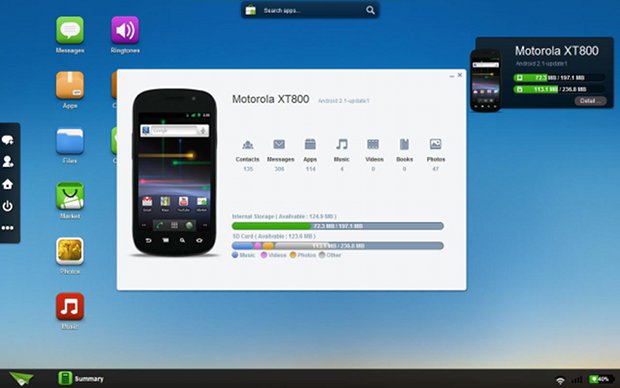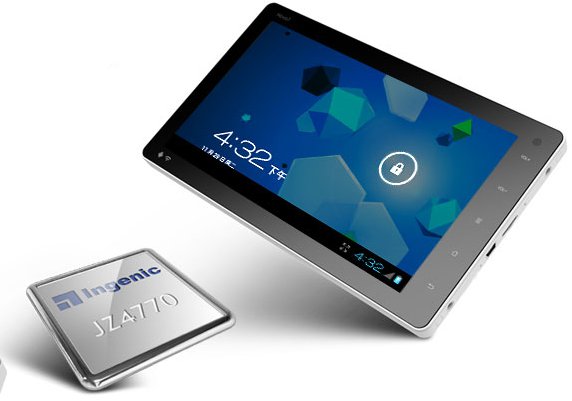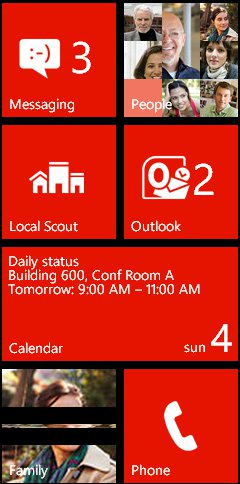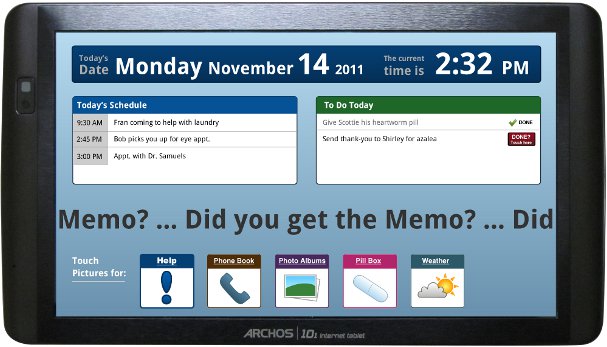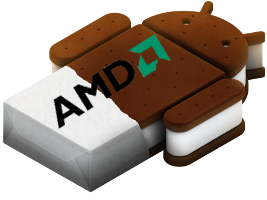AirDroid is a free application that allow you to control your Android smartphone (or tablet) with your computer via WiFi. You simply need to install the app on your smartphone and to connect to the interface with your desktop web browser. You’ll then be able to manage your files, pictures, contacts.. or send SMS with your computer keyboard. You can watch the video below for an overview of AirDroid features: You can download this application at http://market.android.com/details?id=com.sand.airdroid Jean-Luc Aufranc (CNXSoft)Jean-Luc started CNX Software in 2010 as a part-time endeavor, before quitting his job as a software engineering manager, and starting to write daily news, and reviews full time later in 2011. www.cnx-software.com
Android 4.0 on Archos G9
Archos has been working on porting Android 4.0 (ICS) to Archos G9 Series Android Tablet (Archos 80 G9 and 101 G9) and have released a video demo (via Charbax). Archos G9 tablets are powered by OMAP4430 and OMAP4460 (Turbo version) so the port should have been pretty smooth as it is the default SoC used by Android 4.0. Archos still have to complete video hardware acceleration, Samba/Upnp and 3G stick support as well as all other Archos-specific features. The offical Android 4.0 release for Archos G9 should be available by Q1 2012. Jean-Luc Aufranc (CNXSoft)Jean-Luc started CNX Software in 2010 as a part-time endeavor, before quitting his job as a software engineering manager, and starting to write daily news, and reviews full time later in 2011. www.cnx-software.com
99 USD Android 4.0 Tablet (Novo 7) Powered By MIPS Processor
MIPS has just announced the Novo 7 a low cost Android ICS tablet powered by Ingenic’s JZ4770 mobile applications processor that leverages a MIPS-BasedTM XBurstTM CPU running at 1GHz. The new tablet is available with a 7″ capacitive multi-touch screen. 8″ (Novo 8 ) and 9″ (Novo 9) form factors will be available soon. All versions include support for WiFi 802.11 b/g/n, USB 2.0, HDMI 1.3 and microSD, as well as 3D graphics with the Vivante GC860 GPU, 1080p video decoding and dual front/rear cameras (2 MPixel). The XBurst processor’s power-efficient architecture provides extended battery life-the 7″ tablet draws less than 400mA during active web browsing. The Ingenic JZ4770 SoC inside of this (ultra) low cost tablet is one of the first MIPS-based systems-on-chips (SoCs) targeted for mobile devices that delivers 1GHz+ frequency. The JZ4770 SoC is powered by a MIPS32 compatible XBurst CPU designed by Ingenic. The XBurst CPU […]
Ronetix announces Five New Atmel SAM9 CPU Modules
Ronetix announced 5 CPU modules based on Atmel AT91SAM9 series: SAM9G35-CM – populated with AT91SAM9G35 SAM9G25-CM – populated with AT91SAM9G25 SAM9G15-CM – populated with AT91SAM9G15 SAM9X35-CM – populated with AT91SAM9X35 SAM9X25-CM – populated with AT91SAM9X25 Those 5 mew modules correspond to the 5 New Atmel processors and Devkit announced in August 2011. All modules offer 400MHz performance, 128MB to 256MB DDR2 SDRAM, 256MB NAND flash and 4MB to 8MB SPI flash. Here’s a comparison table of the different features available on the 5 modules / processors. Features SAM9G15 SAM9G35 SAM9X35 SAM9G25 SAM9X25 EMAC – RMII RMII MII MII + RMII ADC channels 12 12 12 7 7 CAN – – y – y 5-wires touchscreen y y y – – LCD y y y – – ISI – – – y – additional USART3 – – – y y The modules support the operating supported by SAM9 processors namely Android, […]
Try Windows Phone 7.5 on Your Android / iOS device or Desktop
If you own an Android smartphone or iPhone, and wonder what Microsoft Windows Mobile 7.5 looks like, you can now try it directly inside your phone without installing anything. Microsoft has setup a HTML5 website which offers a working demo of Windows Phone 7.5. It’s obviously not the same as the full OS, but it does allow visitors to experience the look and feeling of Window Phone 7.5 and access applications such as email and calendar. Simply visit http://aka.ms/wpdemo in your mobile phone browser to try the demo. If you don’t own a smartphone yet, you can also try it in your desktop browser. It did not work in Firefox for me, but works fine in Chrome. You can tap to access different menus. Once you are inside a menu, you’ll be asked to swipe or tap to discover the features of the operating systems. All demos are pre-recorded, so […]
Memo Touch: A Tablet for the Elderly
The Memotouch is a tablet based on Archos 101 IT designed for the elderly with short-term memory loss such as persons affected by Alzheimer. Memo helps people with memory loss remember important information by displaying it 24/7 on a 10″ tablet. The elder needs no computer knowledge or skills to benefit from the continual reminders displayed automatically. Messages, audio alerts, and other features are programmed remotely by caregivers (health professionals or family members) through a website. Memo is customizable via the web interface and you can select to either display a single message or also add the following items on the tablet: Calendar To Do List Weather Phone List Pill Box Photo Album Help Button The company sells the tablet for 299 USD, plus 29 USD a month for a 6-month subscription (174 USD Total) or 25 USD a month for a one year subscription (300 USD Total) providing a […]
Android 4.0.1 on x86 processors (Intel / AMD)
Last year, I wrote how to run Android 1.6 in a PC. Android-x86 has since made the newer Android versions available for the following devices: ASUS laptops and tablets. Netbooks such as the ASUS Eee PC Intel Atom tablets such as the Tegav2 Tablet HP Pavilion tx2500 AMD persimmon platform AMD Brazos platform such as the MSI 110W tablet. They now have made Android 4.0.1 available for the AMD Brazos Tablet. Android-x86 4.0-devel live and installation iso for AMD Brazos platform is only a developer’s version as it can not be considered stable just yet. Here are the instructions to get the source code if you want to build it yourself and possibly adapt it to your own hardware: $ repo init -u git://git.android-x86.org/manifest.git -b ics-x86 $ repo sync Android-x86’s Chih-Wei Huang says that WiFi, Multitouch ad OpenGL ES for AMD Radeon works, but sound, camera, Ethernet and hardware acceleration for […]
Android 4.0 Demo on Ziilabs Jaguar Tablet Reference Design
Yet another Android 4.0 demo on a development platform. This time, Android 4.0.1 runs on a Jaguar Tablet powered by Ziilabs ZMS-20 ARM Cortex A9 processor. It runs pretty smoothly. Jean-Luc Aufranc (CNXSoft)Jean-Luc started CNX Software in 2010 as a part-time endeavor, before quitting his job as a software engineering manager, and starting to write daily news, and reviews full time later in 2011. www.cnx-software.com


